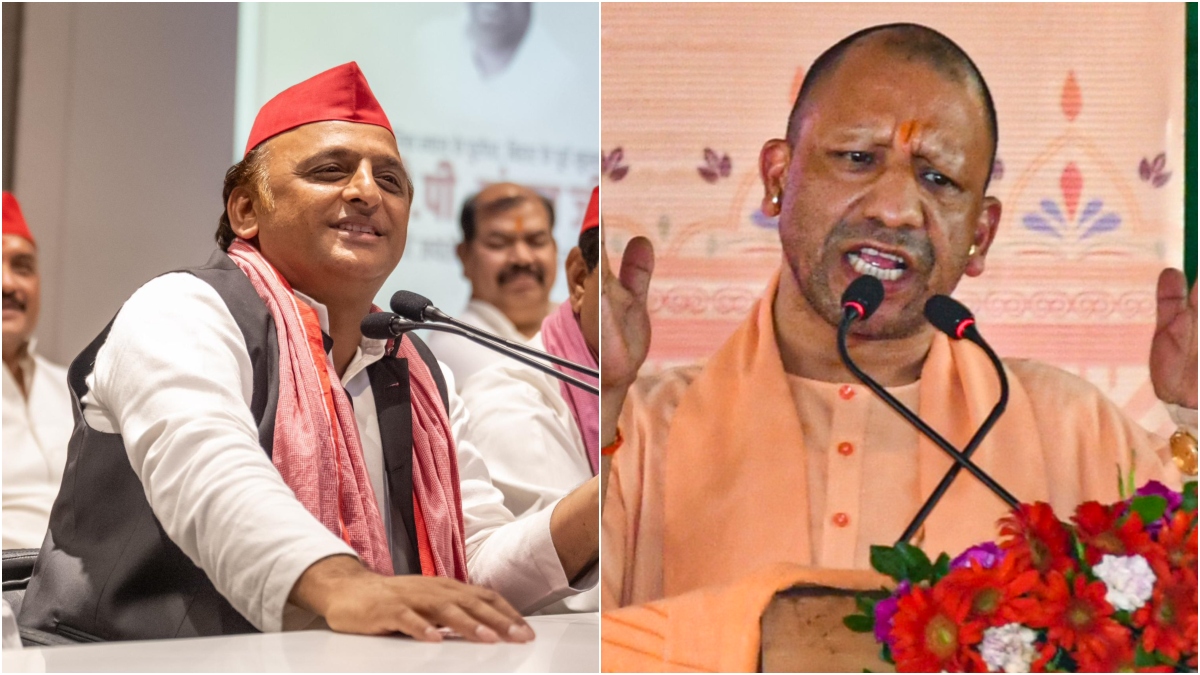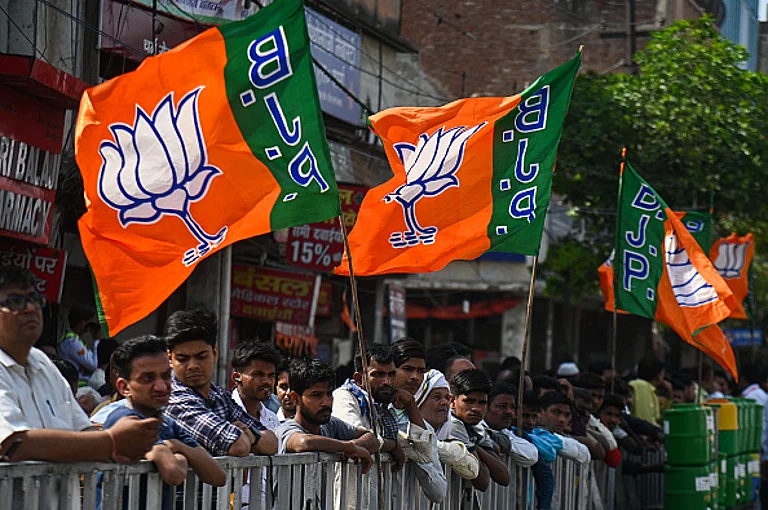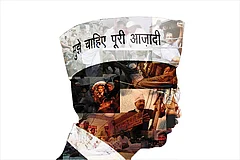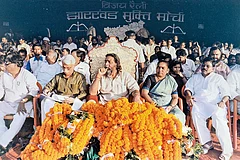“This is the election to save the Constitution and democracy. This is the election to save reservation and one’s own honour. At one point of time, samudra manthan (churning of the sea) had taken place. This is the time for samvidhaan manthan (reclaiming constitutional rights).”
—SP chief Akhilesh Yadav
With just weeks to go for the 2024 Lok Sabha polls, Uttar Pradesh’s Samajwadi Party (SP) is one of the primary competitors to the incumbent Bharatiya Janata Party (BJP) in the state which sends the most number of MPs (80) to the Lok Sabha. The Akhilesh Yadav-led socialist party contesting as part of the INDIA alliance will be looking to inflict maximum damage and to increase its seat tally, which has been limited to five since 2014.

The SP, now united with the grand old party, was originally formed on the premise of an anti-Congress movement to oppose its elitist politics. Over the two decades since its inception, the SP has undergone various transformations in its ideology and structure emerging as what its leaders claim to be a more liberal and inclusive party. The SP was neither an overnight creation nor the manifestation of a single idea. Before it was founded by socialist leader Mulayam Singh Yadav in 1992, the party had assumed various shapes and forms in several alliances, all aimed at furthering the interests of the under-represented backward classes and uplifting the marginalised. A teacher by profession and a wrestler by training, Mulayam was drawn to the socialist ideals of Lohiaite politics from a very early age. Born into a community labelled as lower caste, Mulayam embraced his Other Backward Class (OBC) identity and sought to advance OBC interests and rallied for the community’s rights and representation.
With Ram Manohar Lohia as his political guru, Mulayam’s first political stint was as an MLA from Jaswantnagar in 1967 on a Samyukta Socialist Party (SSP) ticket, a party Lohia was associated with. When his guru Lohia died in 1968, Yadav left the party to join Charan Singh’s Bharatiya Kranti Dal (BKD). For the next twenty years, he transitioned through several groups, parties, factions and alliances, all with the goal of opposing the Congress’ ‘imperialist’ politics.

In 1989, when the Janata Dal—formed after the merger of several political parties—split, Yadav remained with the Samajwadi Janata Party (SJP), a faction of the Janata Dal headed by Chandra Shekhar. It was in 1992 that he broke away to form his own party—the SP. At the broadest level, the SP was presented as a party promoting the principles of liberty, equality, justice and democracy. After the party was founded, it won the UP legislative assembly elections the following year, in alliance with the Kanshi Ram-led Bahujan Samaj Party (BSP). Mulayam became UP chief minister for the second time, the first time under the banner of the SP. The wrestler-turned-politician garnered immense support from sections of the OBC and Muslim communities. His rise in the political realm became a source of great pride among the backward classes who resonated with him.
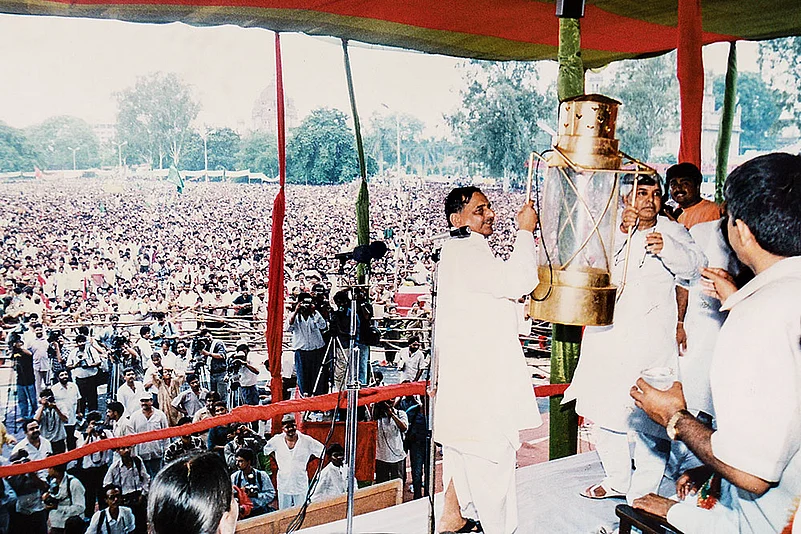
The SP-BSP alliance, which had formed the government along with the support of other parties, collapsed in 1995 when rifts started appearing due to disagreements over the distribution of power and the infamous Meera Bai Marg guest house incident wherein SP workers allegedly misbehaved with Mayawati.
In western Uttar Pradesh, the ‘Jatland’, the residents have seemed to be immune to the socialist politics of the two parties with them failing to evolve a Yadav-Gujar-Muslim combine. Since the 2000s, the SP has on several occasions joined hands with the Rashtriya Lok Dal (RLD), a party formed by farmer leader Chaudhary Ajit Singh, which enjoys a stronghold in western UP. However, in a blow to the opposition, RLD has left the INDIA bloc and joined the BJP just before the 2024 Lok Sabha elections.
Mulayam Singh Yadav’s journey from humble beginnings to a seasoned politician appealed to the masses. for a very long time nobody could imagine someone else as the face of his party.
Over the years, the SP’s anti-Congress stance has also been diluted, particularly as the dominance of their opponent, the Bharatiya Janata Party (BJP), has grown. On multiple occasions, the SP has extended its support in forming the UPA government. In 2017, Rahul Gandhi and Akhilesh Yadav, who came together for the state elections, were seen rallying as ‘UP ke ladke.’
Now, with seat-sharing talks resulting in 63 seats for the SP and 17 for the Congress, the parties jointly contesting under the INDIA coalition will be looking to make a dent in the Modi-led BJP.

Mulayam founded his party on the ideals of secularism and socialism, to advance the interests of the backward classes and minorities. His rise in UP came during the advent of the Mandal-Kamandal politics as he garnered the support of the OBCs. It also happened at a time when feelings of communalism were running high as kar sevaks marched to Ayodhya to demolish the Babri Masjid. As the newly-elected UP chief minister, Yadav declared, “Masjid par parinda bhi par nahin maar sakega,’’ and ordered firing on kar sevaks attempting to destroy the mosque. His opponents gave him the title of “Mullah Mulayam” for his supposedly pro-Muslim approach.
Despite earning the tag, the SP has often been criticised for furthering the interests of only one community: the Yadavs. The party, critics say, has failed in consolidating the backward classes, among which are the upper backward (mostly Yadavs) and lower backward (non-Yadavs) classes, allegedly implementing schemes for and giving key government positions to only the upper classes.
SP chief Akhilesh has been advancing his Pichhda, Dalit, Alpsankhyak (PDA) pitch to attract non-Yadav voters. However, his pitch goes against what is being practised with an apparent lack of representation of non-Yadav OBCs, Dalits and Muslims.
A grassroots politician, three-time chief minister of UP Mulayam was the one around whom the party was centred after its formation in 1992. His journey from humble beginnings to a seasoned politician appealed to the masses for a very long time and nobody could imagine someone else as the face of the party. However, when it was time for Mulayam to hand over the reins, a family feud erupted with his son Akhilesh and his brother Shivpal Yadav fighting for power. The Yadav family split into two groups—one led by Akhilesh with the support of his father’s cousin Ram Gopal Yadav, and the other by Mulayam, supporting his brother Shivpal Singh Yadav. In the end, Akhilesh became the party president in 2017.
MORE FROM THIS ISSUE
Mainpuri is the Yadav family’s bastion from where Mulayam himself used to contest. The seat has remained with the party since 1996. In 2022, Mulayam passed away, vacating the Mainpuri seat. The seat was won by his daughter-in-law Dimple Yadav later in a by-poll. She is again contesting from the constituency for the coming Lok Sabha term. Kannauj had been an SP stronghold since 1998, but in 2019, Dimple lost the seat to BJP’s Subrat Pathak. In 2022, the key SP seat of Azamgarh held by Akhilesh became vacant when he resigned after winning the Karhal constituency in the state elections. The seat was taken over by the BJP’s Dinesh Lal Yadav ‘Nirahua’. The SP won a total of five Lok Sabha seats in the 2019 general elections including Azamgarh, Mainpuri, Moradabad, Rampur and Sambhal.
(This appeared in the print as "Shades of Appeasement")










